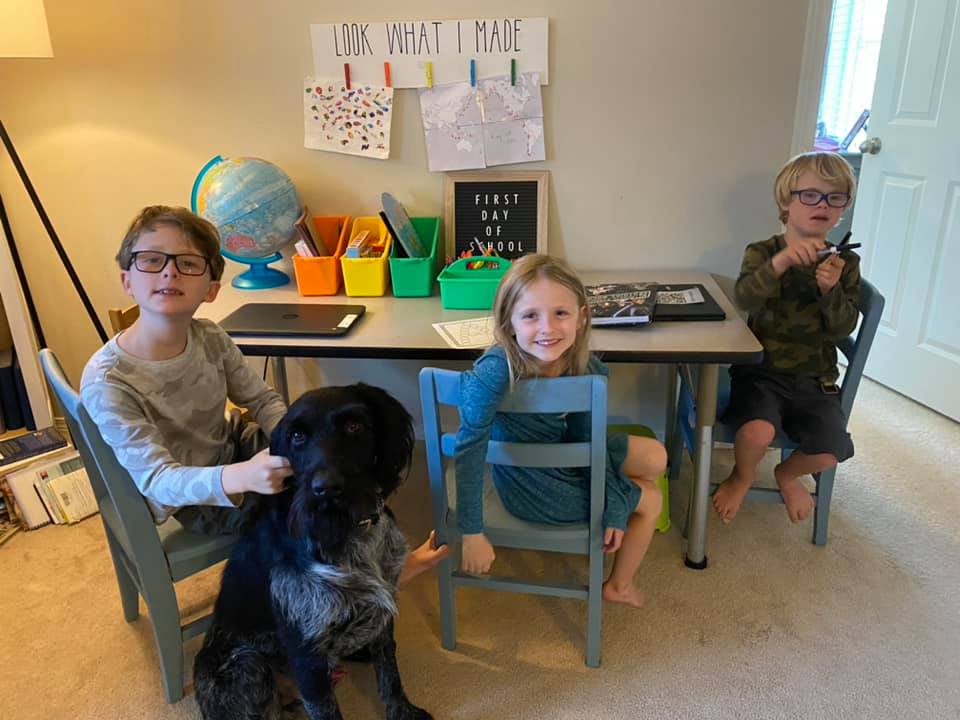NOTE: October is Down Syndrome Awareness Month
A guest blog by Courtney Hansen, Special Education Advocate
Courtney is a non-attorney special education advocate. She advocates at the local, state, and national level for disability rights, and blogs about it at www.inclusionevolution.com
I first shared our family’s story on this blog two years ago. A lot has changed since then, although many things remain the same.
My now 8-year-old twin boys, one who has Down syndrome and the other typically developing, are still included in the same general education class. They still love playing sports together, and our family still leans on our “village” of teachers, therapists, and friends to move forward. Still, this year’s COVID-19 pandemic has set us on a trajectory of change and uncertainty that often feels unsustainable.
In Washington state, where our family is stationed in the military, 90% of school children are starting the school year out virtually. I do not think virtual learning is ideal for most students with disabilities, including my own. I’ve found virtual school poses special challenges for school children with disabilities, who traditionally have been marginalized even during normal times.
Some school districts, including our district, are allowing students with disabilities to do in-person, cohort learning with other students with disabilities.
This may be a needed path to some form of normalcy for many students with disabilities, but it didn’t seem right for our family that one of our twins would be educated in-person; especially because it’s our twin with Down syndrome who’s at higher risk of complications from COVID.
Also, the in-person, cohort learning would mean forfeiting our hard-won fight to have him fully included in general education with his typical twin, even if it’s temporary.
Like everyone else, this is not how we envisioned 2nd grade going.
The global pandemic certainly did not create inequities in education, but it has exposed those inequities to a larger audience.
The collective trauma of the pandemic has impacted every school-aged child, but it’s a trauma that children with disabilities are all too familiar with.
It’s been reported that typical school children are now dealing with issues of isolation, lack of services, and appropriate education. These are not new issues for students with disabilities.
This October, for Down Syndrome Awareness Month, my sons and I are highlighting these issues for all students in their school, and how we can make permanent, positive change for students with disabilities in particular. Our hope is that this seemingly hopeless time will open people’s eyes to needed systems change to make education more equitable.
How do we create real, positive change?
-
Know Your Rights:
The Department of Education has upheld students’ rights under the Individuals with Disabilities Education Act (IDEA) even during the COVID-19 pandemic. This means that your child should be receiving a free and appropriate education and making meaningful progress no matter the current circumstances. Check out the Department of Education’s resource page, which includes topics related to privacy, evaluations, procedural safeguards, and IEP implementation during the pandemic.
Most states have also put out guidance regarding special education and the pandemic. Check your state’s Parent Training and Information website for more state-specific information.
-
Be Your Child’s Best Advocate:
Distance learning was an eye-opener for so many parents, including myself. It forces us to lean into what our children are learning and receiving from school.
In many cases, the parent has become the teacher, paraeducator, and related service provider.
Collecting data of your child’s progress, or lack thereof, will help you make real, positive change for your child.
The TIES Center for inclusive practices and policies is a treasure trove of helpful resources on data collection, grading, emotional well-being, and inclusion during distance learning.
The more we understand our own child’s academic and functional needs, the better we can advocate for them.
-
Emphasize Social-Emotional Learning and Disability Pride:
Education professionals and parents have put a lot of emphasis on how the pandemic will impact children academically, and rightfully so.
Still, there has been little discussion on the social-emotional impact of school closures and virtual learning on students.
My boys are fortunate to be in a school that received a federal grant focusing on the social-emotional needs of military students and other vulnerable populations.
In conjunction with this social-emotional curriculum, our family is advocating for a virtual version of our typical October Disability History month newsletter and classroom lessons.
In my opinion, we all need to take a step back from standardized tests and data plotting to allow students the time to express their emotions during this uncertain time.
It’s only when we listen to others that we realize our hopes, worries, and needs are very similar. This includes students with disabilities, who often want the same things typical students want: high expectations, a sense of belonging, and understanding.
Although this time seems hopeless for some, it’s often the darkest of times that harken needed change.
Students with disabilities and their families continue to demand equity in education.
As a non-attorney special education advocate, I’ve learned that all too often in education a fix only comes after failure or trauma. More people than ever seem ready to intervene and make real change. Let us take this time to reflect on what we should change to move us forward to a more equitable future for all students.
Together we can do virtually anything.
Blog articles provide insights on the activities of schools, programs, grantees, and other education stakeholders to promote continuing discussion of educational innovation and reform. Articles do not endorse any educational product, service, curriculum or pedagogy.



Your story is inspiring. How do I become an advocate for my granddaughter? Do I need specialized training or a certificate from NASET?
I am motivated to become an advocate for “Bella” and other children as well.